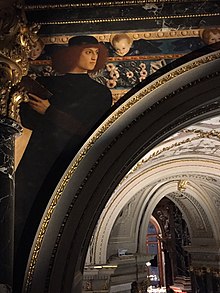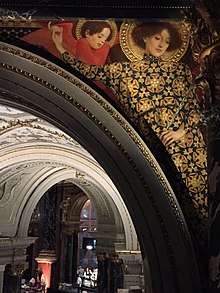Old Italian Art (Klimt)

|
| Old Italian art |
|---|
| Gustav Klimt , 1891 |
| Oil on canvas |
| Kunsthistorisches Museum , Vienna |
Old Italian art is a painting by Gustav Klimt in a pair of gussets and intercolumns on the north wall (right) in the stairwell of the Kunsthistorisches Museum in Vienna from 1891.
Emergence
Klimt executed other spandrel and intercolumned pictures in the stairwell: Roman and Venetian Quattrocento , Greek antiquity and Egypt and Florentine Cinquecento and Quattrocento .
description
Motif and presentation
In the left gusset a young man in black is standing leaning against the arch of the arcade . Flower garlands worked out as a frieze form the background with three angel heads. The young man holds an open book in his hands, but he does not read, but turns his head to the right gusset and looks at the woman standing there. Wrapped in a dress with gold ornaments, she leans against the arcade and lifts her right arm with a beckoning index finger. In her left she is holding a branch of lily . A cherub with red wings appears in the bend of the raised arm . Both the woman and the cherub have a hallmarked nimbus . In the background parts of a frieze with gold ornaments can be seen. The dress appears as a surface interwoven with patterns and creates an optical separation from the vividly painted head and hands of the woman.
In the intercolumn on the right, in front of a dark bust of Dante Alighieri, there is a child in the form of an angel with a nimbus and a golden horse forehead . It wears a light, white robe, the left sleeve of which slides off the shoulder. The woman, the cherub and the angel lower their heads and look down.
If you look at the right gusset image including the adjacent intercolumnium as the right side and contrast it with the left gusset image, the following analogies in the structural structure can be seen, which establish a relationship between the figures:
- young man dressed in dark (left) - dark bust of Dante Alighieri (right)
- three nimbly angel heads on the frieze (left) - three people with nimbly heads (right)
interpretation
The term old Italian is mainly used in linguistics, its use in connection with the fine arts is unusual. In fact, the optically quite inconspicuous bust of Dante in the background of the intercolumnium seems to provide the most important indication of the content of the gusset pictures influenced by literary material, because parallels to the plot of the Divine Comedy , the main work of the poet, can be found in Klimt's portrayal of ancient Italian art . The analogies in the structural composition of the pictures, according to which there is a connection between the bust and the young man, and one could equate the young man with Dante as the figure of the Divina Commedia , underline this theory. The woman in the dress, richly decorated with flowers, would be a representation of Dante's deceased lover Beatrice, who floats down to him in a cloud of flowers and then leads him through the heavenly spheres of paradise, which is illustrated by the alluring index finger. The look downwards emphasizes their position on the heavenly plane together with the angel and cherub, whose red-colored wings can be interpreted as a symbol for love and passion . The lily probably stands for Beatrice's purity .
One shoulder of the angelic boy in the intercolumnium is exposed, which can be interpreted as a subtle erotic depiction and thus an allusion to the role of heterosexuality and homosexuality in Danten's work. In the end, paradise is not denied to love sinners of any kind.
Another possible interpretation arises from the steed shield in the intercolumnium. This type of escutcheon is mainly found in Italian heraldry and is considered a symbol for the Medici . Perhaps Klimt would also like to refer to the role of the Medici as patrons of the arts in Dante's hometown Florence in the intercolumnium . The colors gold, red and blue, characteristic of the Medici coat of arms, and Klimt's right gusset dominate. Furthermore, the lily is an element both in the family coat of arms and in this picture.
Role models and aftermath
role models
With regard to the gusset pictures, two works from the gallery of the Academy of Fine Arts Vienna could be identified as models: Marco Palmezzano's portrait of a young man (around 1490) and the Coronation of Mary attributed to Antonio da Fabriano (1452, originally attributed to Gentile da Fabriano ). The latter inspired Klimt for the floral pattern of the dress. The flower garlands and angel heads on the frieze of the left gusset are reminiscent of the style of Luca della Robbias .
Marco Palmezzano : Portrait of a Young Man , around 1490.
Aftermath
The depiction of the woman in the right gusset of old Italian art is an early example of the separation of body parts and decorative elements (robes, patterned picture backgrounds, etc.). This artistic design principle is characteristic of Klimt's later works, such as B. Judith (1901), Adele Bloch-Bauer I (1907) and The Kiss (1908/09).
literature
- Otmar Rychlik: Gustav Klimt, Franz Matsch and Ernst Klimt in the Kunsthistorisches Museum. Catalog for the special exhibition (Klimt Bridge), Edition Art on behalf of the Kunsthistorisches Museum, Vienna 2012, pp. 49–60.
- Beatrix Kriller, Georg Johannes Kugler: The Art History Museum, the architecture and furnishings . Verlag C. Brandstätter, Vienna 1991, p.
Individual evidence
- ^ Andreas Michel: Introduction to Italian Linguistics, p. 61. Verlag Walter de Gruyter, 2011. ISBN 9783110252545 . Book preview on google .
- ↑ Martin Haase: Italian Linguistics - An Introduction, p. 52ff. Narr Francke Attempto Verlag GmbH, Tübingen 2007. ISBN 978-3-8233-6657-7 .
- ↑ The large art dictionary by PW Hartmann. Retrieved January 8, 2015.
- ↑ Fire and Light in Dante's Divine Comedy , page 7. Article by Christiane Schmidt on the website of the Braunschweigische Wissenschaftlichen Gesellschaft. 2015.
- ↑ Catarine de Medici - family coat of arms of the Medici. Article by Petra Heimbach, April 13, 2013.
- ↑ Gustav Klimt's gusset and inter-column pictures. Article of the Kunsthistorisches Museum, page 2. 2012.
Web links
- Gustav Klimt in the Kunsthistorisches Museum. Extract from the KHM catalogfor the special exhibition (Klimt Bridge) 2012.
- KHM: Bridge brings visitors closer to Klimt. Article by the courier on the special exhibition 2012. With photos of the murals as a slideshow.
- Vienna / KHM: Gustav Klimt in the Kunsthistorisches Museum. New Merker articlefor the 2012 special exhibition.
- The gusset and intercolumned pictures in the stairwell of the KHM. Article by Hedwig Abraham on the website of the Viennatouristguide, July 2002.





